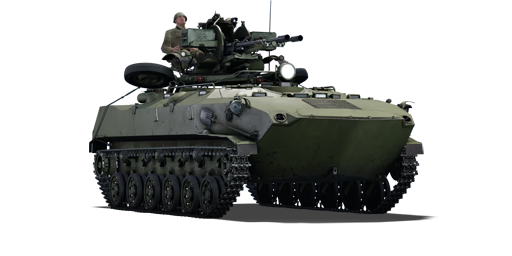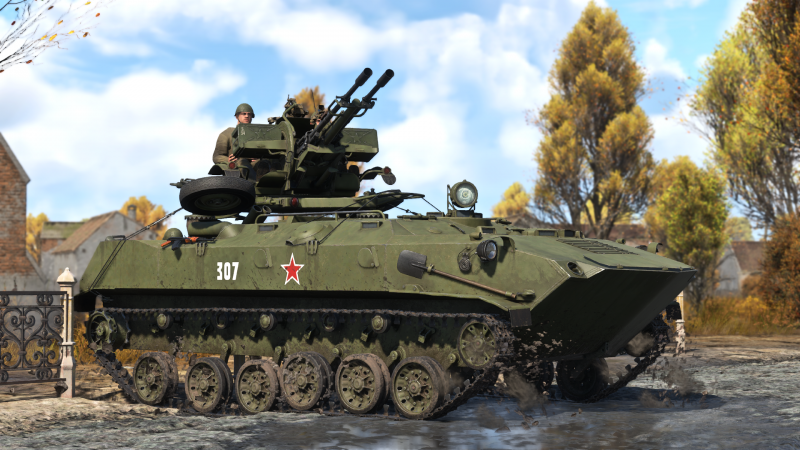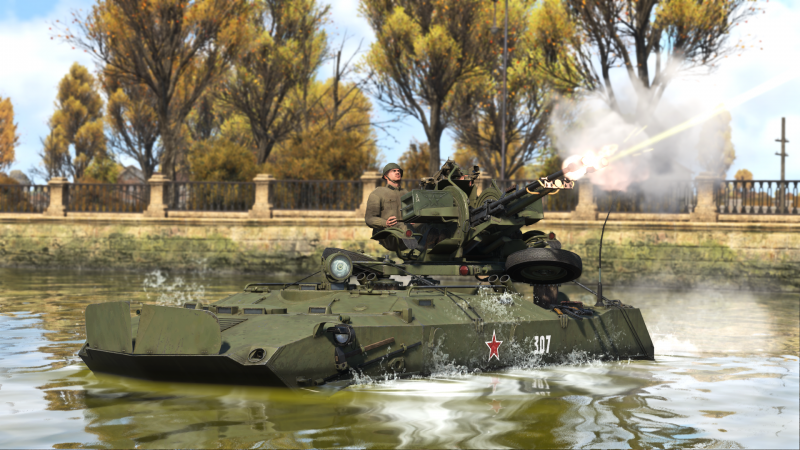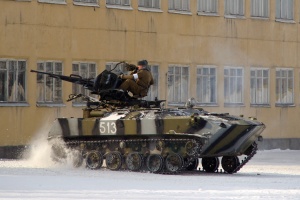Difference between revisions of "BTR-ZD"
Inceptor57 (talk | contribs) (Replaced image; Edits to P&C and History) |
(New description format) |
||
| (18 intermediate revisions by 8 users not shown) | |||
| Line 1: | Line 1: | ||
| + | {{About | ||
| + | | about = Soviet SPAA '''{{PAGENAME}}''' | ||
| + | | usage = the other Soviet SPAA | ||
| + | | link = BTR-152A | ||
| + | }} | ||
{{Specs-Card | {{Specs-Card | ||
|code=ussr_btr_zd | |code=ussr_btr_zd | ||
| − | |images={{Specs-Card-Image|GarageImage_{{PAGENAME}}.jpg}} | + | |images={{Specs-Card-Image|GarageImage_{{PAGENAME}}.jpg|ArtImage_{{PAGENAME}}.png|ArtImage2_{{PAGENAME}}.png}} |
}} | }} | ||
== Description == | == Description == | ||
<!-- ''In the description, the first part should be about the history of the creation and combat usage of the vehicle, as well as its key features. In the second part, tell the reader about the ground vehicle in the game. Insert a screenshot of the vehicle, so that if the novice player does not remember the vehicle by name, he will immediately understand what kind of vehicle the article is talking about.'' --> | <!-- ''In the description, the first part should be about the history of the creation and combat usage of the vehicle, as well as its key features. In the second part, tell the reader about the ground vehicle in the game. Insert a screenshot of the vehicle, so that if the novice player does not remember the vehicle by name, he will immediately understand what kind of vehicle the article is talking about.'' --> | ||
| − | The '''{{Specs|name}}''' | + | The '''{{Specs|name}}''' was a Soviet anti-aircraft vehicle designed with the intent of providing airborne troops with a mobile vehicle with the ability to transport MANPADS. It was developed in the late 1970s and entered service in 1984. As it was intended, it was originally only capable of carrying Strela and Igla MANPADS, but later on the airborne troops came up with the idea of attaching a ZU-23 twin-barrel autocannon on the modified BTR-D chassis. A little while later, the idea was approved by the manufacturers, and the 23mm autocannon began to be pre-installed on factory-built {{Specs|name}}s. These variants also had armored plating around the gun crew to protect them from shrapnel and rifle-caliber fire. Following the dissolution of the Soviet Union, the {{Specs|name}} continued to be used by the Russian Airborne Forces (VDV). |
| + | |||
| + | The {{Specs|name}} was introduced in [[Update "Danger Zone"]]. Based on the BTR-D chassis derived from VDV's BMD-1, the {{Specs|name}} offers devastating twin 23 mm autocannons with good accuracy and rate of fire, as well as being mobile; while having the bare minimal survivability for the crew. It is best to wait until enemies get close before engaging them, as the {{Specs|name}}'s autocannons are most effective at short range. | ||
== General info == | == General info == | ||
| Line 12: | Line 19: | ||
{{Specs-Tank-Armour}} | {{Specs-Tank-Armour}} | ||
<!-- ''Describe armour protection. Note the most well protected and key weak areas. Appreciate the layout of modules as well as the number and location of crew members. Is the level of armour protection sufficient, is the placement of modules helpful for survival in combat? If necessary use a visual template to indicate the most secure and weak zones of the armour.'' --> | <!-- ''Describe armour protection. Note the most well protected and key weak areas. Appreciate the layout of modules as well as the number and location of crew members. Is the level of armour protection sufficient, is the placement of modules helpful for survival in combat? If necessary use a visual template to indicate the most secure and weak zones of the armour.'' --> | ||
| − | + | The BTR-D APC chassis was derived from BMD-1, an airborne IFV of the VDV, designed to be paradropped by transporter aircraft; thus one of its requirements was being light, the extensive use of ABT-101 aluminium alloy ensured its structural integrity while providing a bare minimum of protection for the crew. | |
| − | '''Armour type:''' | + | With the maximum thickness of the armour being 32 mm on the front and two crew members completely exposed, almost anything can take you out. The speed of the vehicle acts as a substitute to the low armour. If the vehicle is shot from the side by an AP round it likely won't do much damage and won't hit the ammo but an HE round will almost certainly take out at least 2 crew members. The spacing of the crew members is disadvantageous as they are all close together and 1 good shot might be able to take them all out. |
| − | + | ||
| − | * | + | '''Armour type:''' |
| + | |||
| + | * Alloy ABT-101 | ||
{| class="wikitable" | {| class="wikitable" | ||
| Line 22: | Line 31: | ||
! Armour !! Front (Slope angle) !! Sides !! Rear !! Roof | ! Armour !! Front (Slope angle) !! Sides !! Rear !! Roof | ||
|- | |- | ||
| − | | Hull || | + | | Hull || 23 mm (63°) ''Top''<br>15 mm (73°) ''UFP''<br>32 mm (48°) ''LFP'' |
| − | | | + | | 23 mm ''Top'' <br>20 mm ''Bottom'' || 20 mm ''Bottom'' || 12 mm |
| − | |||
| − | |||
| − | |||
|- | |- | ||
|} | |} | ||
| − | '''Notes:''' | + | '''Notes:''' |
| − | + | ||
| + | * Suspension wheels are 10 mm thick, tracks are 15 mm thick | ||
=== Mobility === | === Mobility === | ||
{{Specs-Tank-Mobility}} | {{Specs-Tank-Mobility}} | ||
<!-- ''Write about the mobility of the ground vehicle. Estimate the specific power and manoeuvrability, as well as the maximum speed forwards and backwards.'' --> | <!-- ''Write about the mobility of the ground vehicle. Estimate the specific power and manoeuvrability, as well as the maximum speed forwards and backwards.'' --> | ||
| − | + | Thanks to the light weight of the vehicle, its 5D-20 V6 engine can output up to 241 hp and pushes the BTR-ZD to 61 km/h, comparable to its Chinese counterpart [[ZSD63]]; it also has high power-weight ratio. While having sufficient forward speed, it can only go 6 km/h in reverse, so beware of being over-extended. | |
| − | {{tankMobility}} | + | {{tankMobility|abMinHp=341|rbMinHp=212}} |
=== Modifications and economy === | === Modifications and economy === | ||
| Line 50: | Line 57: | ||
{{main|ZU-23 (23 mm)}} | {{main|ZU-23 (23 mm)}} | ||
| − | + | The ZU-23 is perhaps one of the most famous AA autocannon in service, due to the lack of anti-air capabilities of VDV troops in the early stages of being air-dropped. The BTR-ZD straps a ZU-23-2 mount onto the top of the chassis, which has high rate of fire and sufficient penetration to tear down most targets it might see on their sides. Note that it takes a relatively long time to reload its guns, so be sure to make every shot count. | |
{| class="wikitable" style="text-align:center" width="100%" | {| class="wikitable" style="text-align:center" width="100%" | ||
| Line 61: | Line 68: | ||
|- | |- | ||
! ''Arcade'' | ! ''Arcade'' | ||
| − | | rowspan="2" | 500 (50) || rowspan="2" | 800 || rowspan="2" | -10°/+90° || rowspan="2" | ±180° || rowspan="2" | N/A || | + | | rowspan="2" | 500 (50) || rowspan="2" | 800 || rowspan="2" | -10°/+90° || rowspan="2" | ±180° || rowspan="2" | N/A || 52.8 || 73.1 || 88.8 || 98.2 || 104.5 || rowspan="2" | 13.00 || rowspan="2" | 11.50 || rowspan="2" | 10.60 || rowspan="2" | 10.00 |
|- | |- | ||
! ''Realistic'' | ! ''Realistic'' | ||
| − | | | + | | 35.7 || 42.0 || 51.0 || 56.4 || 60.0 |
|- | |- | ||
|} | |} | ||
==== Ammunition ==== | ==== Ammunition ==== | ||
| − | |||
* '''Default:''' {{Annotation|API-T|Armour-piercing incendiary tracer}}{{-}}{{Annotation|HEF-I|High-explosive fragmentation incendiary}} | * '''Default:''' {{Annotation|API-T|Armour-piercing incendiary tracer}}{{-}}{{Annotation|HEF-I|High-explosive fragmentation incendiary}} | ||
| − | * ''' | + | * '''HEFI-T:''' {{Annotation|HEF-I|High-explosive fragmentation incendiary}}{{-}}{{Annotation|HEFI-T|High-explosive fragmentation incendiary tracer}}{{-}}{{Annotation|HEF-I|High-explosive fragmentation incendiary}}{{-}}{{Annotation|API-T|Armour-piercing incendiary tracer}} |
| − | * ''' | + | * '''APIT:''' {{Annotation|API-T|Armour-piercing incendiary tracer}}{{-}}{{Annotation|API-T|Armour-piercing incendiary tracer}}{{-}}{{Annotation|API-T|Armour-piercing incendiary tracer}}{{-}}{{Annotation|HEFI-T|High-explosive fragmentation incendiary tracer}} |
| − | { | + | {{:ZU-23 (23 mm)/Ammunition|HEF-I, API-T, HEFI-T}} |
| − | |||
| − | |||
| − | |||
| − | |||
| − | |- | ||
| − | |||
| − | |||
| − | |||
| − | |||
| − | |||
| − | |||
| − | |||
| − | |||
| − | |||
==== [[Ammo racks]] ==== | ==== [[Ammo racks]] ==== | ||
| − | + | [[File:Ammoracks_{{PAGENAME}}.png|right|thumb|x250px|[[Ammo racks]] of the {{PAGENAME}}]] | |
<!-- '''Last updated:''' --> | <!-- '''Last updated:''' --> | ||
{| class="wikitable" style="text-align:center" | {| class="wikitable" style="text-align:center" | ||
| Line 101: | Line 93: | ||
! 4th<br>rack empty | ! 4th<br>rack empty | ||
! 5th<br>rack empty | ! 5th<br>rack empty | ||
| − | |||
! Visual<br>discrepancy | ! Visual<br>discrepancy | ||
|- | |- | ||
| − | | '''10''' || | + | | '''10''' || 8 ''(+2)'' || 6 ''(+4)'' || 4 ''(+6)'' || 2 ''(+8)'' |
| + | |0 ''(+10)''|| Yes | ||
|- | |- | ||
|} | |} | ||
| Line 113: | Line 105: | ||
{{main|PKT (7.62 mm)}} | {{main|PKT (7.62 mm)}} | ||
| − | + | An unusual feature of BTR-ZD is having a pair of hull machine guns (not modelled in X-ray view); although being practically useless any against armoured targets, they could still be used to gun down exposed crews in rare cases. | |
{| class="wikitable" style="text-align:center" width="50%" | {| class="wikitable" style="text-align:center" width="50%" | ||
| Line 121: | Line 113: | ||
! Mount !! Capacity (Belt) !! Fire rate !! Vertical !! Horizontal | ! Mount !! Capacity (Belt) !! Fire rate !! Vertical !! Horizontal | ||
|- | |- | ||
| − | | || | + | | Hull || 500 (250) || 700 || ±2° || ±3° |
|- | |- | ||
| − | | || | + | | Hull || 500 (250) || 700 || ±2° || ±3° |
|- | |- | ||
|} | |} | ||
| Line 129: | Line 121: | ||
== Usage in battles == | == Usage in battles == | ||
<!-- ''Describe the tactics of playing in the vehicle, the features of using vehicles in the team and advice on tactics. Refrain from creating a "guide" - do not impose a single point of view but instead give the reader food for thought. Describe the most dangerous enemies and give recommendations on fighting them. If necessary, note the specifics of the game in different modes (AB, RB, SB).'' --> | <!-- ''Describe the tactics of playing in the vehicle, the features of using vehicles in the team and advice on tactics. Refrain from creating a "guide" - do not impose a single point of view but instead give the reader food for thought. Describe the most dangerous enemies and give recommendations on fighting them. If necessary, note the specifics of the game in different modes (AB, RB, SB).'' --> | ||
| − | Due to being made out of | + | Due to being made out of ABT-101 aluminium alloy and the thickest area of the armour being 32 mm at the front of the vehicle, a head on engagement with a ground vehicle is not recommended, especially against vehicles with high-calibre machine guns or autocannons. If used against ground targets, make good use of the BTR-ZD's high mobility and flank the enemies to avoid being immediately sent back to the hangar. Most HE rounds will decimate the vehicle right away, even if it somehow survives the hit, the exposed crew will not have a good day. When facing heavier targets (such as [[Churchill (Family)|Churchills]]), chances are the autocannons onboard with relatively low penetration will be practically useless against any WWII heavy tanks, so either disable their tracks or just avoid them at all costs. When encountering vehicles with strong frontal armour but weak side armour (such as the [[Jagdpanzer 38(t)|Hetzer]]) try to flank and take them out by shooting at their sides. |
| − | When engaging air targets try to take out the target before it shoots back because if it does the gunner and loader | + | When engaging air targets, try to take out the target before it shoots back, because if it does the gunner and loader will almost certainly be rendered unconscious and will leave you vulnerable to follow up attacks. Since the vehicle is amphibious, a strategy that can be used on maps with rivers and bridges (in maps like European Province) is to peek out under the bridge to fire, then hide in the bridge arches to reload, or make good use of the waterways to sneak up on the enemies and deliver a surprise attack. As with any SPAA, it is also suggested to stay close to cover to avoid gun strafing, bombs, and rockets. Lastly it is advised to stay near trees so that you can quickly go behind them and make it harder to spot you while you are reloading, or use your mobility to quickly change positions. |
[[File:Btr-zd Belarus.jpg|thumb]] | [[File:Btr-zd Belarus.jpg|thumb]] | ||
=== Pros and cons === | === Pros and cons === | ||
| − | <!-- ''Summarise and briefly evaluate the vehicle in terms of its characteristics and combat effectiveness. Mark its pros and cons in a bulleted list. Try not to use more than 6 points for each of the characteristics. Avoid using categorical definitions such as "bad", "good" and the like - use substitutions with softer forms such as "inadequate" and "effective".'' -->'''Pros:''' | + | <!-- ''Summarise and briefly evaluate the vehicle in terms of its characteristics and combat effectiveness. Mark its pros and cons in a bulleted list. Try not to use more than 6 points for each of the characteristics. Avoid using categorical definitions such as "bad", "good" and the like - use substitutions with softer forms such as "inadequate" and "effective".'' --> |
| + | |||
| + | '''Pros:''' | ||
| − | * Very | + | * Very high rate of fire, easy to intercept fast targets |
| − | * All ammo types have enough | + | * All ammo types have enough penetration for most light and medium tanks, like [[M24 (Family)|M24]], [[Sd.Kfz.234 (Family)|Sd.Kfz.234]] |
* Night vision capabilities | * Night vision capabilities | ||
* Amphibious | * Amphibious | ||
| − | * Fast for | + | * Fast for an SPAA |
* Has 2 forward facing 7.62 mm machine guns | * Has 2 forward facing 7.62 mm machine guns | ||
'''Cons:''' | '''Cons:''' | ||
| − | * | + | * Low survivability: thin armour on the hull and exposed gunner and loader |
| − | + | * Can be pierced by 12.7 mm machine guns and larger-calibre weapons | |
| − | * Can be pierced by 12.7 mm machine guns | ||
* Guns overheat fast if not fired in bursts | * Guns overheat fast if not fired in bursts | ||
| + | * Slow -6 km/h reverse speed | ||
== History == | == History == | ||
<!-- ''Describe the history of the creation and combat usage of the vehicle in more detail than in the introduction. If the historical reference turns out to be too long, take it to a separate article, taking a link to the article about the vehicle and adding a block "/History" (example: <nowiki>https://wiki.warthunder.com/(Vehicle-name)/History</nowiki>) and add a link to it here using the <code>main</code> template. Be sure to reference text and sources by using <code><nowiki><ref></ref></nowiki></code>, as well as adding them at the end of the article with <code><nowiki><references /></nowiki></code>. This section may also include the vehicle's dev blog entry (if applicable) and the in-game encyclopedia description (under <code><nowiki>=== In-game description ===</nowiki></code>, also if applicable).'' --> | <!-- ''Describe the history of the creation and combat usage of the vehicle in more detail than in the introduction. If the historical reference turns out to be too long, take it to a separate article, taking a link to the article about the vehicle and adding a block "/History" (example: <nowiki>https://wiki.warthunder.com/(Vehicle-name)/History</nowiki>) and add a link to it here using the <code>main</code> template. Be sure to reference text and sources by using <code><nowiki><ref></ref></nowiki></code>, as well as adding them at the end of the article with <code><nowiki><references /></nowiki></code>. This section may also include the vehicle's dev blog entry (if applicable) and the in-game encyclopedia description (under <code><nowiki>=== In-game description ===</nowiki></code>, also if applicable).'' --> | ||
| − | + | The BTR-ZD (Бронетранспортёр- Зенитная Десанта; lit Anti-aircraft APC for airborne troops) was based on the BTR-D APC, which was again based on the BMD-1 IFV for the VDV (Soviet/Russian Airborne Troops). After the introduction of the BMD-1 in VDV service in 1969, the vehicle was deemed too small for practical transport capabilities; so the Volgograd Tractor Factory (BMD-1's manufacturer) built a new APC for the VDV based on BMD-1, with a longer hull while removing its original turret system. The new BTR-D entered the service in 1974. | |
| + | |||
| + | This variant, dubbed "Скрежет" (a metal file) installed a ZU-23-2 autocannon onto its chassis and it was projected that the crew would also carry a squadron with MANPADS, serving as a field anti-aircraft position for the airborne troops. | ||
== Media == | == Media == | ||
<!-- ''Excellent additions to the article would be video guides, screenshots from the game, and photos.'' --> | <!-- ''Excellent additions to the article would be video guides, screenshots from the game, and photos.'' --> | ||
| − | + | ||
| + | ;Skins | ||
| + | * [https://live.warthunder.com/feed/camouflages/?vehicle=ussr_btr_zd Skins and camouflages for the {{PAGENAME}} from live.warthunder.com.] | ||
== See also == | == See also == | ||
| Line 175: | Line 173: | ||
* ''other literature.'' --> | * ''other literature.'' --> | ||
| − | * http://www.military-today.com/artillery/btr_zd.htm | + | * [[wt:en/news/7729-development-btr-zd-gun-savvy-en|[Devblog] BTR-ZD: Gun Savvy]] |
| − | + | * [http://www.military-today.com/artillery/btr_zd.htm <nowiki>[Military Today]</nowiki> BTR ZD] | |
| − | * https://weaponsystems.net/system/64-BTR-ZD%20%22Skrezhet%22 | + | * [https://weaponsystems.net/system/64-BTR-ZD%20%22Skrezhet%22 <nowiki>[Weapon Systems]</nowiki> BTR-ZD "Skrezhet"] |
{{USSR anti-aircraft vehicles}} | {{USSR anti-aircraft vehicles}} | ||
Latest revision as of 11:56, 5 August 2023
| This page is about the Soviet SPAA BTR-ZD. For the other Soviet SPAA, see BTR-152A. |
Contents
Description
The BTR-ZD was a Soviet anti-aircraft vehicle designed with the intent of providing airborne troops with a mobile vehicle with the ability to transport MANPADS. It was developed in the late 1970s and entered service in 1984. As it was intended, it was originally only capable of carrying Strela and Igla MANPADS, but later on the airborne troops came up with the idea of attaching a ZU-23 twin-barrel autocannon on the modified BTR-D chassis. A little while later, the idea was approved by the manufacturers, and the 23mm autocannon began to be pre-installed on factory-built BTR-ZDs. These variants also had armored plating around the gun crew to protect them from shrapnel and rifle-caliber fire. Following the dissolution of the Soviet Union, the BTR-ZD continued to be used by the Russian Airborne Forces (VDV).
The BTR-ZD was introduced in Update "Danger Zone". Based on the BTR-D chassis derived from VDV's BMD-1, the BTR-ZD offers devastating twin 23 mm autocannons with good accuracy and rate of fire, as well as being mobile; while having the bare minimal survivability for the crew. It is best to wait until enemies get close before engaging them, as the BTR-ZD's autocannons are most effective at short range.
General info
Survivability and armour
The BTR-D APC chassis was derived from BMD-1, an airborne IFV of the VDV, designed to be paradropped by transporter aircraft; thus one of its requirements was being light, the extensive use of ABT-101 aluminium alloy ensured its structural integrity while providing a bare minimum of protection for the crew.
With the maximum thickness of the armour being 32 mm on the front and two crew members completely exposed, almost anything can take you out. The speed of the vehicle acts as a substitute to the low armour. If the vehicle is shot from the side by an AP round it likely won't do much damage and won't hit the ammo but an HE round will almost certainly take out at least 2 crew members. The spacing of the crew members is disadvantageous as they are all close together and 1 good shot might be able to take them all out.
Armour type:
- Alloy ABT-101
| Armour | Front (Slope angle) | Sides | Rear | Roof |
|---|---|---|---|---|
| Hull | 23 mm (63°) Top 15 mm (73°) UFP 32 mm (48°) LFP |
23 mm Top 20 mm Bottom |
20 mm Bottom | 12 mm |
Notes:
- Suspension wheels are 10 mm thick, tracks are 15 mm thick
Mobility
Thanks to the light weight of the vehicle, its 5D-20 V6 engine can output up to 241 hp and pushes the BTR-ZD to 61 km/h, comparable to its Chinese counterpart ZSD63; it also has high power-weight ratio. While having sufficient forward speed, it can only go 6 km/h in reverse, so beware of being over-extended.
| Game Mode | Max Speed (km/h) | Weight (tons) | Engine power (horsepower) | Power-to-weight ratio (hp/ton) | |||
|---|---|---|---|---|---|---|---|
| Forward | Reverse | Stock | Upgraded | Stock | Upgraded | ||
| Arcade | 67 | 7 | 9 | 341 | 458 | 37.89 | 50.89 |
| Realistic | 62 | 7 | 212 | 240 | 23.56 | 26.67 | |
Modifications and economy
Armaments
Main armament
The ZU-23 is perhaps one of the most famous AA autocannon in service, due to the lack of anti-air capabilities of VDV troops in the early stages of being air-dropped. The BTR-ZD straps a ZU-23-2 mount onto the top of the chassis, which has high rate of fire and sufficient penetration to tear down most targets it might see on their sides. Note that it takes a relatively long time to reload its guns, so be sure to make every shot count.
| 23 mm ZU-23 (x2) | Turret rotation speed (°/s) | Reloading rate (seconds) | ||||||||||||
|---|---|---|---|---|---|---|---|---|---|---|---|---|---|---|
| Mode | Capacity (Belt) | Fire rate | Vertical | Horizontal | Stabilizer | Stock | Upgraded | Full | Expert | Aced | Stock | Full | Expert | Aced |
| Arcade | 500 (50) | 800 | -10°/+90° | ±180° | N/A | 52.8 | 73.1 | 88.8 | 98.2 | 104.5 | 13.00 | 11.50 | 10.60 | 10.00 |
| Realistic | 35.7 | 42.0 | 51.0 | 56.4 | 60.0 | |||||||||
Ammunition
- Default: API-T · HEF-I
- HEFI-T: HEF-I · HEFI-T · HEF-I · API-T
- APIT: API-T · API-T · API-T · HEFI-T
| Penetration statistics | |||||||
|---|---|---|---|---|---|---|---|
| Ammunition | Penetration @ 0° Angle of Attack (mm) | ||||||
| 10 m | 100 m | 500 m | 1,000 m | 1,500 m | 2,000 m | ||
| HEF-I | 6 | 6 | 4 | 3 | 2 | 2 | |
| API-T | 51 | 48 | 36 | 26 | 18 | 13 | |
| HEFI-T | 6 | 6 | 4 | 3 | 2 | 2 | |
| Shell details | ||||||||||||
|---|---|---|---|---|---|---|---|---|---|---|---|---|
| Ammunition | Velocity (m/s) |
Projectile mass (kg) |
Fuse delay (m) |
Fuse sensitivity (mm) |
Explosive mass (TNT equivalent) (g) |
Ricochet | ||||||
| 0% | 50% | 100% | ||||||||||
| HEF-I | 980 | 0.18 | 0.1 | 0.1 | 28.49 | 79° | 80° | 81° | ||||
| API-T | 970 | 0.19 | - | - | - | 47° | 60° | 65° | ||||
| HEFI-T | 970 | 0.19 | 0.1 | 0.1 | 20.02 | 79° | 80° | 81° | ||||
Ammo racks
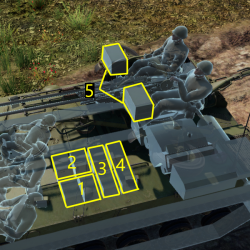
| Full ammo |
1st rack empty |
2nd rack empty |
3rd rack empty |
4th rack empty |
5th rack empty |
Visual discrepancy |
|---|---|---|---|---|---|---|
| 10 | 8 (+2) | 6 (+4) | 4 (+6) | 2 (+8) | 0 (+10) | Yes |
Machine guns
An unusual feature of BTR-ZD is having a pair of hull machine guns (not modelled in X-ray view); although being practically useless any against armoured targets, they could still be used to gun down exposed crews in rare cases.
| 7.62 mm PKT | ||||
|---|---|---|---|---|
| Mount | Capacity (Belt) | Fire rate | Vertical | Horizontal |
| Hull | 500 (250) | 700 | ±2° | ±3° |
| Hull | 500 (250) | 700 | ±2° | ±3° |
Usage in battles
Due to being made out of ABT-101 aluminium alloy and the thickest area of the armour being 32 mm at the front of the vehicle, a head on engagement with a ground vehicle is not recommended, especially against vehicles with high-calibre machine guns or autocannons. If used against ground targets, make good use of the BTR-ZD's high mobility and flank the enemies to avoid being immediately sent back to the hangar. Most HE rounds will decimate the vehicle right away, even if it somehow survives the hit, the exposed crew will not have a good day. When facing heavier targets (such as Churchills), chances are the autocannons onboard with relatively low penetration will be practically useless against any WWII heavy tanks, so either disable their tracks or just avoid them at all costs. When encountering vehicles with strong frontal armour but weak side armour (such as the Hetzer) try to flank and take them out by shooting at their sides.
When engaging air targets, try to take out the target before it shoots back, because if it does the gunner and loader will almost certainly be rendered unconscious and will leave you vulnerable to follow up attacks. Since the vehicle is amphibious, a strategy that can be used on maps with rivers and bridges (in maps like European Province) is to peek out under the bridge to fire, then hide in the bridge arches to reload, or make good use of the waterways to sneak up on the enemies and deliver a surprise attack. As with any SPAA, it is also suggested to stay close to cover to avoid gun strafing, bombs, and rockets. Lastly it is advised to stay near trees so that you can quickly go behind them and make it harder to spot you while you are reloading, or use your mobility to quickly change positions.
Pros and cons
Pros:
- Very high rate of fire, easy to intercept fast targets
- All ammo types have enough penetration for most light and medium tanks, like M24, Sd.Kfz.234
- Night vision capabilities
- Amphibious
- Fast for an SPAA
- Has 2 forward facing 7.62 mm machine guns
Cons:
- Low survivability: thin armour on the hull and exposed gunner and loader
- Can be pierced by 12.7 mm machine guns and larger-calibre weapons
- Guns overheat fast if not fired in bursts
- Slow -6 km/h reverse speed
History
The BTR-ZD (Бронетранспортёр- Зенитная Десанта; lit Anti-aircraft APC for airborne troops) was based on the BTR-D APC, which was again based on the BMD-1 IFV for the VDV (Soviet/Russian Airborne Troops). After the introduction of the BMD-1 in VDV service in 1969, the vehicle was deemed too small for practical transport capabilities; so the Volgograd Tractor Factory (BMD-1's manufacturer) built a new APC for the VDV based on BMD-1, with a longer hull while removing its original turret system. The new BTR-D entered the service in 1974.
This variant, dubbed "Скрежет" (a metal file) installed a ZU-23-2 autocannon onto its chassis and it was projected that the crew would also carry a squadron with MANPADS, serving as a field anti-aircraft position for the airborne troops.
Media
- Skins
See also
Links to the articles on the War Thunder Wiki that you think will be useful for the reader, for example:
- reference to the series of the vehicles;
- links to approximate analogues of other nations and research trees.
External links
| USSR anti-aircraft vehicles | |
|---|---|
| GAZ-AAA | GAZ-AAA (4M) · GAZ-AAA (DShK) |
| BTR-152 | BTR-152A · BTR-152D |
| Wheeled/Half-tracked | GAZ-MM (72-K) · ZiS-12 (94-KM) · ZiS-43 |
| Radar SPAAG | ZSU-23-4 · ZSU-37-2 |
| SAM | ZSU-23-4M4 · Strela-10M2 · 2S6 · Pantsir-S1 |
| Other | ZSU-23-4M2 · ZUT-37 · ZSU-37 · BTR-ZD · ZSU-57-2 |
| Czechoslovakia | M53/59 |
| North Vietnam | ▂Phòng không T-34 |


